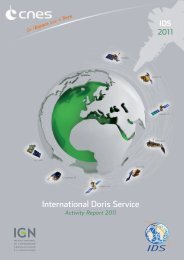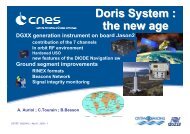ALTIKA : A MICRO-SATELLITE Ka-BAND ALTIMETRY MISSION
ALTIKA : A MICRO-SATELLITE Ka-BAND ALTIMETRY MISSION
ALTIKA : A MICRO-SATELLITE Ka-BAND ALTIMETRY MISSION
You also want an ePaper? Increase the reach of your titles
YUMPU automatically turns print PDFs into web optimized ePapers that Google loves.
strong rain rates : nevertheless, the development ofnew algorithms taking into account rainperturbations of the altimeter echoes is necessary andpresently under study.Of course, even if not presented in this note, thepresence of the DORIS system and of a laserretroreflector array in the Alti<strong>Ka</strong> package ensuresthat the classically required orbitographyperformances will be reached and that the Alti<strong>Ka</strong>altimeter series may be linked toTOPEX/POSEIDON, Jason and ENVISAT series ina well monitored geodetic reference frame.one being to have the 3 satellites flying on differentorbit planes that would be separated up to 0.24degree corresponding to one third of the typical 35day ground track spacing (formation flying). These 2configurations may of course answer differentlyspace time requirements of high resolution oceanaltimetry and maybe inputs for ocean simulation toillustrate their relative interest in terms of sciencereturn.Preliminary studies have shown that a microsatelliteplatform such as the MYRIADE series underdevelopment at CNES is well suited to embark theAlti<strong>Ka</strong> payload (Figure 2). A recent study has beenperformed considering a classical sun-synchronous35 day ENVISAT-type orbit (6 am ascending node)at an altitude of 800 km and a 98 degree inclination,also requiring a +/- 1km repeatability for the groundtrack. The main issues relating with theaccommodation of the Alti<strong>Ka</strong> payload on themicrosatellite platform have been analyzed : mass,power, pointing, fields of view of the variousinstruments, TM/TC rate, thermal andelectromagnetic environment, etc. A detailed reportis still under writing at the present time, theconclusion of it being that Alti<strong>Ka</strong> is a validcandidate for the embarkment on such amicrosatellite.Figure 3 : Example of accommodation of 3 Alti<strong>Ka</strong>microsatellites inside a DNEPR fairingFigure 2 : Artist view of Alti<strong>Ka</strong> satelliteDuring the same study, a very preliminary analysisof possibly launching several (up to 3) Alti<strong>Ka</strong>microsatellites with the same small launcher hasbeen performed (Figure 3). The feasibility of such anapproach has been assessed for 2 configurations :one is to have 3 satellites flying in the same orbitplane with a 120 degree lag in terms of position onthe orbit (classical constellation type), the secondIt shall be noticed that the technical studies that arereferred to are preliminary ; they need to beconsolidated by more detailed analysis including thepossibility of considering other microsatelliteplatforms and launchers. However, the results thatare presented demonstrate the potential of <strong>Ka</strong>-bandaltimetry both in technical and performances aspects,validating the Alti<strong>Ka</strong> concept for a high performancecontinuation of ENVISAT altimetry and topotentially contribute in high resolution altimetry.Finally, it may be stressed that the <strong>Ka</strong>-band altimeterpayload defined above may be embarked as apassenger of opportunity missions as a complementto existing altimeters such as the POSEIDON ones :






